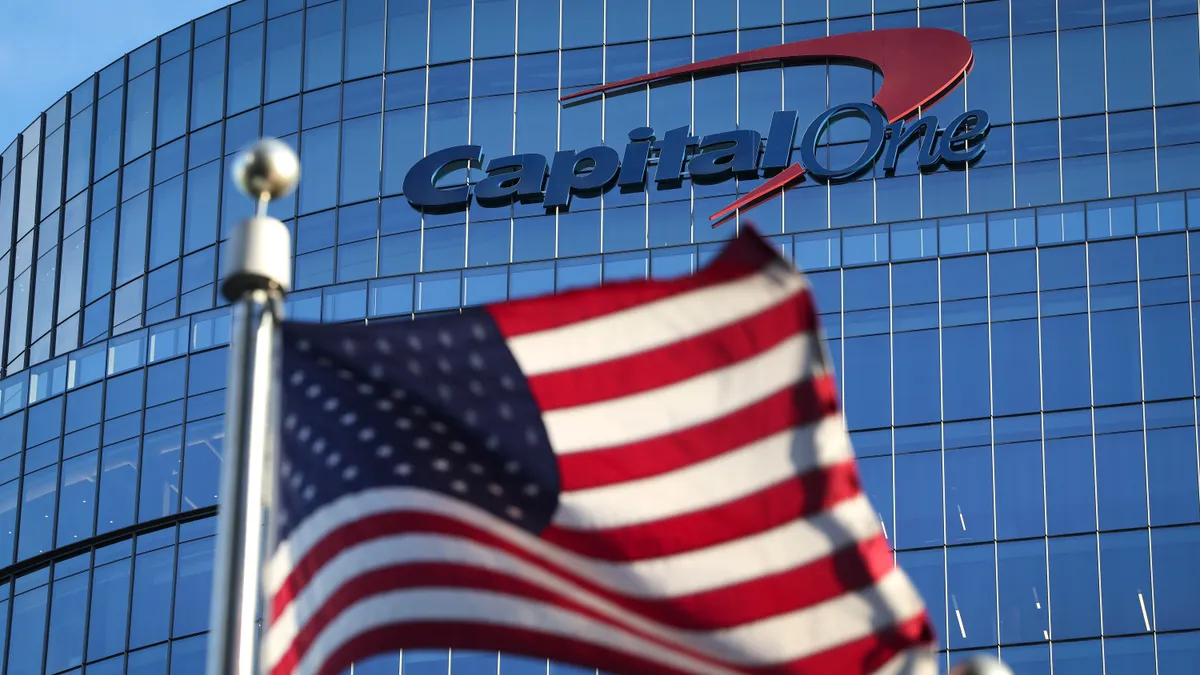Dive Brief:
-
Capital One's $35.3 billion proposed merger with Discover topped the list of tech-related merger-and-acquisition deals announced globally in the first three months of the year, according to PitchBook.
-
Overall, tech-related deals proposed in the first quarter reached $183.7 billion in aggregate value, representing a 68% quarterly jump and an increase of 85% year over year, according to preliminary PitchBook data shared with CFO Dive. This is subject to change slightly as new information is constantly being added to PitchBook’s platform, a spokesperson said.
-
The spike reflects increased confidence in corporate boardrooms amid improving macroeconomic conditions, according to PitchBook analyst Tim Clarke. “Unless there’s a crisis on the horizon that no one foresees at present, we’re set up for an M&A recovery in the tech sector and more broadly this year,” he said in an interview.
Dive Insight:
Pitchbook identified the proposed Capital One-Discover merger as a tech-related deal because of fintech issues that are in the mix, Clarke said.
The proposed merger is a bid by Capital One to protect itself against a rising tide of fintech and regulatory threats, according to a CNBC report.
“This deal gives [Capital One] a stronger hand to battle other banks, fintechs and big tech companies,” Keefe, Bruyette & Woods analyst Sanjay Sakhrani told the news outlet. “The more that they can separate themselves from the pack, the more they can future-proof themselves.”
Other large tech-related deals proposed in the first quarter include Synopsys’s $35 billion agreement to acquire engineering software firm Ansys, as well as Hewlett Packard Enterprise’s $14 billion bid for Juniper Networks.
In all, 1,932 tech-related deals were announced in the first quarter, a 10.7% decrease compared with the fourth quarter of 2023, and a 27.2% decrease year over year, according to PitchBook’s preliminary numbers. Clarke said the deal count may soon drift upward and “even up” with the fourth quarter as a lot of small transactions are reported late.
“Because they’re little deals, they don’t really impact the deal value that much,” he said. Meanwhile, Pitchbook could end up reporting a less dramatic rise in aggregate deal value if some transactions, particularly large ones, are withdrawn.
The latest figures come after a dismal year for M&A in 2023 overall. The total value of global M&A deals closed or announced in 2023 across sectors fell to $3 trillion, a 15.8% decrease from 2022, PitchBook reported in January.
“The guessing game among M&A professionals and firms at this point is whether the current down cycle will extend another year,” the report said. “Not since the downturn of 2007 during the global financial crisis has the M&A market gone down for three straight years. For historical reference, that decline measured 60.0% in deal value before bottoming in 2009, concurrent with a 29.3% contraction in deal count. We do not anticipate that.”
CEO optimism in the economy rose this quarter to the highest level in two years as inflation cooled and the Federal Reserve indicated that it expects in coming months to begin trimming the highest borrowing costs in 23 years, the Conference Board and Business Council found in a survey released in February, as previously reported by CFO Dive.
Concerns about a possible recession have largely diminished, and now the markets are looking forward to relief on the interest rate front, Clarke said.
“If those hopes are dashed, that would be bad for companies that have already built in an expectation,” he said.
Tech deals face a mix of both headwinds and tailwinds this year, according to James Brundage, a partner in Big Four accounting firm Ernst & Young’s strategy and transactions practice. “Despite the headwinds, we expect the tailwinds to move us forward and increase M&A,” he said in an interview.
Along with improvements in the economy, M&A activity could be spurred by factors such as rising pressure for companies to show a trajectory toward growth, Brundage said.
“A lot of times, growth for tech companies has come through M&A, which is one of the reasons why we’re more bullish on 2024 versus 2023,” he said. The growing pressure to keep pace with advancements in artificial intelligence is another potential driver for M&A activity this year, he said.
Besides high interest rates that still need to come down, other potential headwinds facing M&A include geopolitical uncertainty and increased antitrust regulation in the U.S. and abroad, according to Brundage.
In January, Amazon and robot vacuum maker iRobot said they were calling off their $1.7 billion merger deal in the face of opposition from EU and U.S. antitrust regulators. In December, Adobe terminated its $20 billion agreement to acquire software provider Figma because it saw “no clear path to receive necessary regulatory approvals from the European Commission and the UK Competition and Markets Authority.”
“There’s much more aggressive antitrust oversight going on,” Brundage said. “It’s definitely a headwind to tech M&A, especially for the very large incumbent players who will probably have difficulty getting large-scale transactions done.”
The increased regulatory scrutiny is leading to higher break-up fees in tech deals, a trend that will likely continue, he said.
It’s also requiring companies to become more thorough when assessing the antitrust risks of a potential deal before moving forward, according to Victor Boyajian, a partner at the law firm Dentons and global chair of its Venture Technology and Emerging Growth Companies practice.
“Companies increasingly need to think about how a deal will be viewed by antitrust regulators,” he said. “That is a decision point that you’re seeing discussed earlier and earlier on in transactions.”












